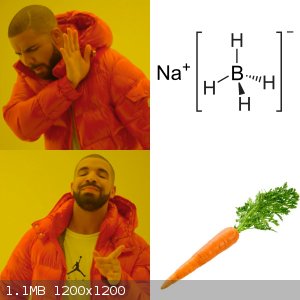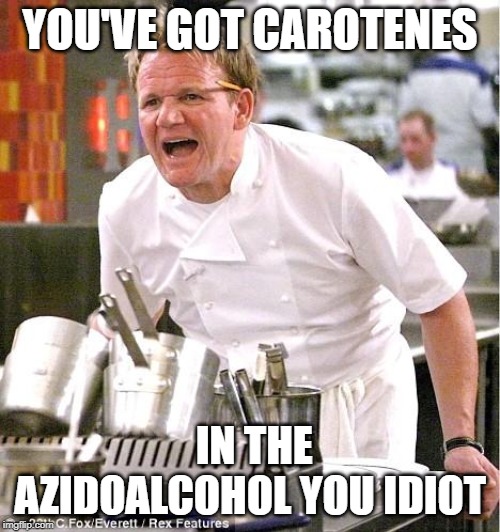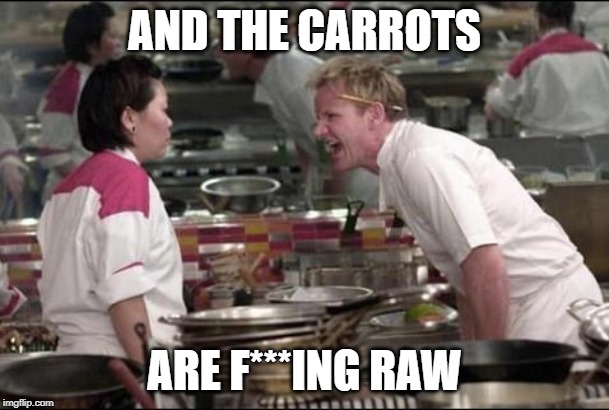| Pages:
1
2 |
karlos³
International Hazard
    
Posts: 1520
Registered: 10-1-2011
Location: yes!
Member Is Offline
Mood: oxazolidinic 8)
|
|
bioreduction of ketones to chiral alcohols with carrot slices
So as I am a fan of chiral bioreductions using yeast, I have sooner or later(actually at least three years ago) stumbled upon yeast reductions using
daucus carota, i.e. carrots.
I am just right now in the process of running a reduction of an azidoketone(the azide of 2-acetonaphthone) using carrot slices, leading to an
(R)-azidoalcohol.
Usually, it will give an (S)-alcohol, just not in the case of azidoketones.
Attached are a few interesting papers about this certain case of reduction.
I have 1,2l of tap water with 200g of carrot slices up on the stirrer, and dropped 2g of azidoacetonaphthone dissolved in 30ml ethanol in it, causing
a milky appearance of the mixture.
I think that has quite some advantage over yeast, since you won't end up with more cells than you started with, and thus have an easier work-up
without the slime of yeast trapping product.
I just hope the workup will be as easy.
Already bought thousand seeds of the wild carrot type, since their hairy root culture is said to work much better here.
Attachment: carrot bioreduction 2.pdf (293kB)
This file has been downloaded 885 times
Attachment: ketone reduction carrots.pdf (46kB)
This file has been downloaded 856 times
Attachment: ketone reduction carrots compendium.pdf (47kB)
This file has been downloaded 781 times
|
|
|
Metacelsus
International Hazard
    
Posts: 2539
Registered: 26-12-2012
Location: Boston, MA
Member Is Offline
Mood: Double, double, toil and trouble
|
|
Wow! I never would have thought that carrot could do this. I'm excited to see if it worked for you.
|
|
|
karlos³
International Hazard
    
Posts: 1520
Registered: 10-1-2011
Location: yes!
Member Is Offline
Mood: oxazolidinic 8)
|
|
We will see over the course of the week 
I am sure some crossed fingers will be beneficiary 
|
|
|
lab-equip
Harmless

Posts: 13
Registered: 8-10-2016
Member Is Offline
Mood: No Mood
|
|
Nice input thanks very much!
|
|
|
karlos³
International Hazard
    
Posts: 1520
Registered: 10-1-2011
Location: yes!
Member Is Offline
Mood: oxazolidinic 8)
|
|
Ok so I filtered the carrot slices out after almost four days of vigorous stirring, washed them with 3x80ml of water and then put the combined soup
without furthers treatment into a large sep funnel.
I extracted the liquid with 3x80ml of DCM, washed that with water and brine, and dried it over Na2SO4.
Then I distilled the solvent off and was left with 1,4g of a yellow oil, which tested negative on ketones with DNP.
So I assume it is the alcohol(maybe with some organic crap in there too).
Next time I will use a julienne cutter to get a maximum surface area instead of thin carrot slices, I guess it will be easier to stir then too.
It was really easier to get rid of the biocatalyst compared to yeast, actually I used a sieve to remove the carrot slices and afterwards during the
extraction no emulsion occured like it can easily happen with yeast.
|
|
|
Praxichys
International Hazard
    
Posts: 1063
Registered: 31-7-2013
Location: Detroit, Michigan, USA
Member Is Offline
Mood: Coprecipitated
|
|
Just as long as nobody mistakes it for soup. 
Have you assessed the chirality of the product at all?
|
|
|
karlos³
International Hazard
    
Posts: 1520
Registered: 10-1-2011
Location: yes!
Member Is Offline
Mood: oxazolidinic 8)
|
|
Mmhhm, organic azide soup, tastes good, but only once 
No I haven't checked the chirality, and I don't plan to do it, lacking the instruments.
I will straight up continue and reduce it to the amine with zinc and ammonium formate and then put that amino alcohol to nefarious uses not suitable
for the SM board 
E: oh, and the theoretical yield from 9,4mmol of azidoacetonaphthone to the produced alcohol amounted to 6,5mmol or 69,5%(assumed it is all the
product).
I don't even plan any further purification, I will just use it as it is for the reduction.
[Edited on 16-10-2019 by karlos³]
|
|
|
Metacelsus
International Hazard
    
Posts: 2539
Registered: 26-12-2012
Location: Boston, MA
Member Is Offline
Mood: Double, double, toil and trouble
|
|
Quote: Originally posted by karlos³  |
Then I distilled the solvent off and was left with 1,4g of a yellow oil, which tested negative on ketones with DNP.
So I assume it is the alcohol(maybe with some organic crap in there too).
|
Carotenes, perhaps? 
|
|
|
Texium
Administrator
       
Posts: 4580
Registered: 11-1-2014
Location: Salt Lake City
Member Is Offline
Mood: PhD candidate!
|
|

|
|
|
Praxichys
International Hazard
    
Posts: 1063
Registered: 31-7-2013
Location: Detroit, Michigan, USA
Member Is Offline
Mood: Coprecipitated
|
|
Two can play at that game.
  
|
|
|
karlos³
International Hazard
    
Posts: 1520
Registered: 10-1-2011
Location: yes!
Member Is Offline
Mood: oxazolidinic 8)
|
|
Lamb sauce? Not without carrots!
How sweet of you, you made memes for this 
I thought the yellow colour could be beta carotenes too, but then again, the azidoketone was already a somewhat yellow liquid.
|
|
|
SWIM
National Hazard
   
Posts: 970
Registered: 3-9-2017
Member Is Offline
|
|
If surface area is important, is there some reason not to just grate them?
Coarse carrot gratings like they put in potato salad might be stirrable and present greater surface area.
Carrot peelings too. They're even thinner.
If you'd like a richer, more complex flavor for your reaction mixture you could always throw in some celery and 1/2 an onion along with a bouquet
garni.
(I'm just pointing this out before Happyfoodance does.)
|
|
|
karlos³
International Hazard
    
Posts: 1520
Registered: 10-1-2011
Location: yes!
Member Is Offline
Mood: oxazolidinic 8)
|
|
Gratings will work even better, for sure, and thus I will use them the next time.
Plants have the advantage that they don't propagate and result in a slime of cell mass, trapping product and all.
I just used slices because that one paper said that, next time I will use something even better like gratings.
Oh no celery will provide the opposite enantiomer(at least for normal ketones, instead of (S)- it will lead to (R)-alcohols)!
I wanted the (R)-alcohol.
But I remember that celery the next time I cook the residual carrots up in a stew 
I don't remember which enantiomer the onions result in, but these also work... I guess it sounds to someone uneducated like were talking soup recepts
here 
|
|
|
karlos³
International Hazard
    
Posts: 1520
Registered: 10-1-2011
Location: yes!
Member Is Offline
Mood: oxazolidinic 8)
|
|
bioreduction of ketones to chiral alcohols with celery gratings!
Ok so I was thinking long and hard about which ketone to reduce next with plant matter, and then I remembered the attached japanese document about the
yeast reduction of masked primary aminoketones(e.g. N-alkyl phthalimides, succinimides, saccharines).
Initially I wanted to use phenacyl saccharin because saccharines gave the best yield with yeast, but I would have to prepare it first from
bromoacetophenone.
But then I remembered that I already had some phthalimidoacetophenone ready, made years earlier.
So I grated 200g celery, put them in a 2l widemouth flask with a large stirbar, added 1,2l tap water and a bit of citrate buffer to reach a pH of 6,5.
Then added the 2,14g phenacylphthalimide(8mmol) dissolved in 100ml of ethanol dropwise, causing a milky appearance as it suspended in the mixture.
The whole lot was heated to 30°C in the water bath.
Now we'll wait...
Attachment: hefereduktion phthalimidoketone.pdf (7.7MB)
This file has been downloaded 640 times
|
|
|
karlos³
International Hazard
    
Posts: 1520
Registered: 10-1-2011
Location: yes!
Member Is Offline
Mood: oxazolidinic 8)
|
|
I have to say, on the second day I added 5g polysorbate, tween 80, to the celery based reduction to help the reaction as some kind of PTC substitute.
PEG-400 would probably work likewise or even better but I don't have that.
On the fifth day I filtered the celery out, and washed the residual celery three times with 50ml water, and then I pressed the fluids out of the mush.
Then extracted the milky fluid with 3x80ml DCM, pooled that, and washed it once with water and brine, then dried it over sodium sulfate.
Distilled the DCM off and was left with a bit of a yellow oil, which I filled into a vial and weighed it.
It amounted to 0,53g, which corresponds to 24,7% of the theory(1,98mmol).
Surprisingly, it crystallised a few minutes later into small sugar-like yellow crystals, which still appear to look a bit moist.
I have not yet attempted to purify it further via recrystallisation I have to add, but so far it looks good, I can probably take a mp test in the
future after I recrystallised that stuff.
Edit: I have to add, I did not run a TLC on the product as it is likely not that pure(even has a faint hint of celery odour), I have only checked for
the presence of ketones with DNP to confirm it has reacted.
Gratings really work well and these plant matter based reductions sure are a lot of fun!
Something very unusual, but I really start to like this method.
I believe the low yield in this case could be due to the phthalimide substitution, as the japanese paper suggest, since phthalimides gave the lowest
yield of them all.
Once I did a bioreduction with yeast on phenacyl succinimide, that gave a higher yield as could be expected than this bioreduction with celery.
I really need to try it again on phenacyl saccharin with celery or carrots to satisfy my curiosity.
[Edited on 11-11-2019 by karlos³]
|
|
|
karlos³
International Hazard
    
Posts: 1520
Registered: 10-1-2011
Location: yes!
Member Is Offline
Mood: oxazolidinic 8)
|
|
I did it again, but this time on a ketone called benzylmethyl ketone, using celery.
200g celery, 1,2l of tap water and citrate buffer(pH 6,5), and dropped the ketone in 100ml ethanol with 3g polysorbate 80 in.
Five days later, the usual workup, and the obtained 1,09g of (R)-1-Phenyl-2-propanol were ketone free tested with DNP(which is a yield of 53,7% of the
theory).
However, the smell is very interesting, as the racemic 1-phenyl-2-propanol smells like roses as everyone who worked with it knows, but the
(R)-enantiomer smells citric/wooden with a hint of mayflowers.
The (S)-enantiomer, obtained by yeast reduction smells different, a hint of roses, but mostly earthy.
|
|
|
stoichiometric_steve
National Hazard
   
Posts: 827
Registered: 14-12-2005
Member Is Offline
Mood: satyric
|
|
In order to easify the workup, it would be prudent to try cold pressed carrot or celery juice (prefer the latter because it mostly lacks carotenes).
|
|
|
karlos³
International Hazard
    
Posts: 1520
Registered: 10-1-2011
Location: yes!
Member Is Offline
Mood: oxazolidinic 8)
|
|
I don't know if there are enough cells left?
But compared with yeast, the veggie cells don't reproduce, so the workup is pretty easy and not even close as prone to forming emulsions.
I will form the tosylate of the obtained (R)-alcohol next, this will be helpful to indicate if the chirality is right, as the tosylates of (S)- and
(R)-enantiomer differ according to the attached document in their melting points for around 5°C.
[Edited on 12-12-2019 by karlos³]
Attachment: phpMThQQI (99kB)
This file has been downloaded 754 times
|
|
|
G-Coupled
Hazard to Others
  
Posts: 287
Registered: 9-3-2017
Member Is Offline
Mood: Slightly triturated
|
|
Can regular liquid Propylene Glycol be substituted for the PEG-400?
Also, are yeast cells that hard to break apart to release the wanted product?
[Edited on 12-12-2019 by G-Coupled]
|
|
|
karlos³
International Hazard
    
Posts: 1520
Registered: 10-1-2011
Location: yes!
Member Is Offline
Mood: oxazolidinic 8)
|
|
I haven't used PEG-400, I used tween 80.
The product with yeast cells isn't in the cells, it is produced outside of course.
How would it even be incorporated?
Yeast release enzymes in the solution, where the substrate is, and the enzymes and the substrate react together.
The cells can trap the product, but not inside their cells, but in the cell mass in between.
But yeast cells aren't hard to break apart if you ever want to make yeast extract to flavour your food, they simply hydrolyze with acid.
|
|
|
karlos³
International Hazard
    
Posts: 1520
Registered: 10-1-2011
Location: yes!
Member Is Offline
Mood: oxazolidinic 8)
|
|
Coconut water! Wow!
See this here! https://pdfs.semanticscholar.org/aa98/5b25ba836f8c88d2dd70e7...
And check this paper here! 
https://sci-hub.se/10.1016/j.molcatb.2008.06.022
So steve was somewhat looking in the right direction with his suggestion of using juice 
That is an enzyme brew that is not comparable for ease of workup with any cell suspension, now I really have to try this one out, how cool!
[Edited on 20-12-2019 by karlos³]
|
|
|
karlos³
International Hazard
    
Posts: 1520
Registered: 10-1-2011
Location: yes!
Member Is Offline
Mood: oxazolidinic 8)
|
|
Oh man, the hunt for green coconuts in the middle of winter in europe is way too hard!
I bought three of the ripened variety, but could only collect 140ml of the filtered coconut water.
And the stuff sold in tetra paks is heat treated, so the enzymes are likely denaturized.
However, I found something that sounds likewise good, and which is probably better to store(i.e., doesn't need pasteurisation to be conserved).
Sugar cane juice!
Likewise without any plant matter unlike the veggie reductions, and containing only conserving agents like benzyl alcohol etc, no heat treatment
destroying the enzymatic action of the stuff.
Here are the related papers:
Attachment: Edible_catalysts_for_clean_chemical_reactions_Bior.pdf (184kB)
This file has been downloaded 586 times
Attachment: 10.1016@j.molcatb.2008.01.004.pdf (356kB)
This file has been downloaded 551 times
Attachment: bauer1946.pdf (781kB)
This file has been downloaded 587 times
[Edited on 10-1-2020 by karlos³]
|
|
|
stoichiometric_steve
National Hazard
   
Posts: 827
Registered: 14-12-2005
Member Is Offline
Mood: satyric
|
|
Take indian papers with a train of salt, said an indian friend of mine. They're mostly bullshit writeups made to look legit.
"...was obtained by perforating the fruit with a metallic sharp object
(knife)" — I LOLED PRETTY HARD
Anyways, you can always just blend some celery and remove the coarse plant matter by sedimentation, should have plenty of free cells.
|
|
|
karlos³
International Hazard
    
Posts: 1520
Registered: 10-1-2011
Location: yes!
Member Is Offline
Mood: oxazolidinic 8)
|
|
You think that is sufficient?
I will try that, I got a new mixer for xmas and celery really is the best if you want an (R)-alcohol 
Although I am lately quite fond of the Spirulina bioreductions, I already want to get a culture for health benefits, but the outcome is usually
(S)-alcohols.
Anyway, you can get to the (S)-amine if you use this superior iodination technique of the alcohol using iodine in mesylic acid, the resulting
(R)-iodide will do a walden-flip anyways 
|
|
|
stoichiometric_steve
National Hazard
   
Posts: 827
Registered: 14-12-2005
Member Is Offline
Mood: satyric
|
|
I think it is worth a try, considering how cheap your starting material is. Just blend it and let it settle for not too long, then use the
supernatant.
Hasn't Spirulina been debunked for health? I remember researching this many years ago but the conclusion was that it's all bollocks.
|
|
|
| Pages:
1
2 |